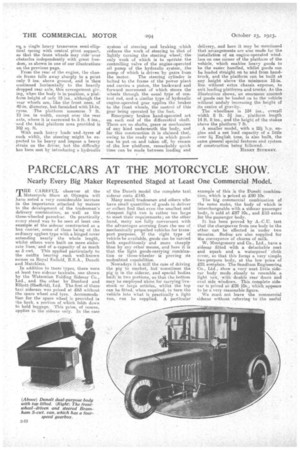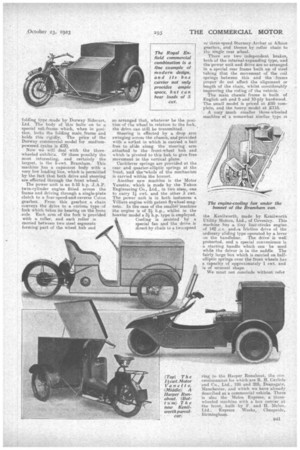PARCELCARS AT THE MOTORCYCLE SHOW.
Page 22

Page 23

If you've noticed an error in this article please click here to report it so we can fix it.
Nearly Every Big Maker Represented Staged at Least One Commercial Model.
THECAREFUL observer at the Motorcycle Show at Olympia will have noted a very considerable increase in the importance attached by makers to the development of the tradesman's delivery combination, as well as the three-wheeled pareelcar. On practically _ avert' stand was to be seen at least one example of the sidecar constructed as a box carrier, some of these being ot the ordinary eggbex type with a hinged cover extending nearly the whole length, whilst others were lonilt on more elaborate lines: and of a-capacityof as much as 5 cwt. This applied particularly to the outfits bearing .such well-known siame,s as Royal Enfield, B.S.A., Dunelt and Matchless.
addition to these' types, there were at least two sidecar taxicabs, one. shown by the Watsonian Folding Sidecar Co., 'Ltd., and. the other by Dunford and Elliott (Sheffield), Lid. The first of these taxi sidecars was,priced at £63 without the snare wheel and tyre. Accommodation for the spare wheel is provided in the back, a portion of which folds down to bold luggage. This price, of course, applies to the sidecar only. In the case of the Durielt model the ccimplete taxi sidecar costs £14.5.
' Many small tradesmen and others who have small quantities of goods to deliver or collect find that even the smallest and cheapest light yan is rather too large to meet their requirements; on the Other hand, many are fully conversant with the advantages accruing from the use of mechanically propelled vehicles for trans: port purposes. If the right type of vehicle be available, goods can he cal-Tied both expeditiously and more cheaply than by any other means, and here it is that the light goods-carrying combination or three-wheeler is preying its undoubted capabilities.
Nowadays it is Min the rase of driving the pig to market, but sometimes the pig is in the sidecar, and special bodies built in two portions, so that the bottom may he employed alone for carrying livestock or large articles, whilst the top can he fitted, when required, to turn the vehicle into what is practically a light van, can be supplied. A particular example of this is the Durielt combination, which is priced at £90 10s.
The big commercial combination of the tattle make, the body of which is interchangeable with a sidecar passenger body, is sold at £87 10s., and .£15 extra for the passenger body.
It has been proved by A.-C.U. test that the changeover from one body to the other, can be effected in under two minutes. Bodies are also supplied for the conveyance of churns of milk.
W. Montgomery and Co., Ltd., have a sidecar fitted with a detachable seat and squaband a waterproof cloth cover, so that this formS a very simple two-purpose body, at the. low price of £21 complete. The Sandham Engineering Co., Ltd., show a very neat little sidecar body made..closely to resemblea light van, with double rear doors and oval Side windows. This complete sidecar is priced at £26 10s., Whieh. appears to be a very reasonable figure.
We must not leave the commercial sidecar without referring to the useful folding type made by DorwaySidecars, Ltd. The body of this bolts on to a special sub-frame which, when in position, locks the folding main frame and holds this rigidly_ The price of the Dorwa.y commercial model for medium. powered cycles is £20,.
Now we will deal' with the threewheeled exhibits. Of these possibly the most interesting, and certainly the largest, is the 5-cwt. Bramham. This machine has .a capacious body with a very low loading line, which is permitted by the fact that both drive and steering are effected through the front wheel.
The power unit is an 8-10 h.p. J.A.P. twin-cylinder engine fitted across the frame and driving through a single-plate clutch to a four-speed-and-reverse Caton gearbox. Freer, this gearbox a chain conveys the drive to a curious type • of fork which takes its bearing on the front a.sle. Each arm of the fork is provided with a roller, and. each roller is carried between two steel segments forming part of the wheel huh and so arranged that, whatever he the position of the wheel, in relation to the fork, the drive can still be transmitted.
Steering is effected by a drop arm swinging across the chassis, and prov ided with a sorket in which is carried a bail free to slide along the steering arm Attached to the front-wheel huh and which is pivoted to this hub to give free movement in the vertical plane.
Cantilever springs are provided at the rear and quarter-elliptic springs at the front, and the%whoIe of the mechanism is carried within the bonnet.
Another new machine is the Motor Vanette, which is made by the Yukon Engineering Co., Ltd., in two sizes, one to carry 11 mt. and the other 3 cwt. The power unit is iri both instances a Villiers engine with patent flywheel mag-note. In the case of the smaller—Machine The engine is of 2 h.p., whilst in the heavier model a 3i h.p. type is employed. Cooling is assisted by a special fan and the drive is direct by chain to a twospeed
or three-speed Sturiney-Archer or Albion gearbox, and thence by roller chain to the single rear wheel.
There are two independent brakes, both of the internal-expanding type, and the power unit and drive are so arranged in a spacial rear frame built .up of steel tubing that the movement of the coil springs between this and the frame proper do not affect the alignment or length of the chain, whilst considerably improving the riding of the vehicle.
The main chassis frame is built of English ash and 5 and 10-ply hardwood.
The small model is priced at complete, and the heavy model at £115.
A very much smaller three-wheeled machine of a somewhat similar type is the Kenilworth, made by Kenilworth Utility Motors, Ltd., of Coventry. This machine has a tiny four-stroke engine of 142 ...c.c. antLea friction drive of the ordinary sliding type operated by a lever an the handlebar. The drive is wet protected, and a special convenience is a starting handle which can be used while the driver is in the saddle. The fairly large box which is carried on halfelliptic springs over the front wheels has a capacity of approximately 1 cwt. and is of unusual shape.
We must not conclude without refer ring to the Harper Runabout, the concessionnaires for which are II. H. Carlisle.. and Co., Ltd., la and 205, Deansgate, Manchester, and which we have already described as a commercial vehicle. There is also the Meier' Express, a threewheeled machine with a box carrier at the front, built by F. and H. Melee, Ltd., Express Works, Cheapside, Birmingham.






























